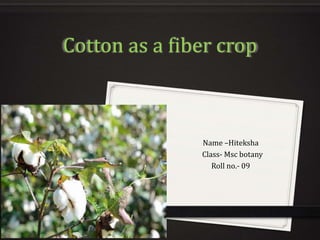
Cotton as a fibre crop
- 1. Cotton as a fiber crop Name –Hiteksha Class- Msc botany Roll no.- 09
- 2. Classification 0 Kingdom : Plantae 0 Order : Malvales 0 Family : Malvaceae 0 Sub family : Malvoideae 0 Tribe : Gossypieae 0 Genus : Gossypium
- 3. Outline:- 0 Introduction 0 Origin and evolution 0 Varieties 0 Life cycle ( fiber to fabrics) 0 Processing 0 Diseases 0 Utilization
- 4. Introduction 0 Cotton is a natural fiber, it is a prolongation of epidermal cells of the seed coat. 0 It is a soft, fluffy ,staple fiber that grows in a ball or protective capsule around the seed of cotton plant of the genus Gossypium. 0 It is also called king of fibers which is white in color. 0 This is a shrub native to tropical and subtropical areas around the world including America, Africa & India.
- 5. Morphology of the plant 0 Cotton is a perennial shrub attaining a height of 1 -2 meter. 0 The leaves are simple and palmately lobed where Stipules are free lateral. 0 The flowers are solitary, axillary, regular and bisexual and are large and showy with yellow corolla . 0 Sepals are persistent. 0 The corolla has five petals with monadelphous , epipetalous stamens. 0 The gynoecium is pentacarpellary with a superior ovary and axile placentation. 0 The fruit is a locullicidal capsule. It is commonly called as cotton ball. 0 In India it is mainly a kharif crop, Sowing is done in June or July. 0 It is grown in a variety of soils such as Indo gangetic alluvium , black cotton soil , and lateritic soil containing a good proportion of humus.
- 6. History & origin 0Cotton is the most important and oldest fiber of the world. The existence of cotton is found in Rig Veda written around 1500 BC. India remained the chief producer of cotton until 1500 BC. 0The earliest evidence of cotton use in the Indian subcontinent has been found at the site of Mehrgarh and Rakhigarhi (Haryana)where cotton threads have been found preserved in copper beads(b/w 6000- 5000BC). 0 Cotton cultivation in the region is dated to the Indus Valley Civilization which covered parts of Eastern Pakistan and Northwestern India between 3000-1000 BC.
- 7. Evolution of cotton:- 0 Out of about 50 species of genus Gossypium, the word 'cotton' refer to only 4 species are cultivated and are used for spinable fibers rest 46 species distributed world-wide in tropical and sub- subtropical regions are designated as wild species. 0 These wild species are important source of functional traits such as fiber properties, resistance to abiotic and biotic stresses, and cytoplasmic male sterility which can be utilized for improvement of cultivated species through introgressive breeding. 0 Out of 50 species, 43 diploid species (with 2n = 26) have been grouped into seven genome from A to G, whereas rest of the 7 tetraploid species (with 2n =52) have been designated into other genome
- 8. Four cultivated Varieties of cotton Gossypium hirsutum– upland cotton, native to Central America, Mexico, the Caribbean and southern Florida (90% of world production) 0 Gossypium barbadense– known as extra-long staple cotton, native to tropical South America (8% of world production) 0 Gossypium arboreum– tree cotton, native to India and Pakistan (less than 2%) 0 Gossypium herbaceum– Levant cotton, native to southern Africa and the Arabian Peninsula (less than 2%)
- 9. Life cycle of cotton plant
- 10. Processing of cotton 0 . Ginning baling picking carding combingDrawing/drafting
- 11. CHARACTERISTICS OF COTTON FIBERS 0 Cotton fibers are epidermal hairs present on the seed coat. 0 The mature cotton fiber is translucent with collapsed hollow tube. 0 The primary wall of the cotton fiber is thin , elastic and coated with chitin. 0 The secondary thickenings are in the form of concentric rings. 0 The raw cotton contains 94% cellulose , 3% proteins , 0.9% pectin , 0.6 % ,wax- 0.3% ,sugars and 1-2% ash. 0 Now they are classified on the basis of their length as long fibre , intermediate and short fibers.
- 12. Cotton Plant Parts & Utilization 0 Root Drugs 0 Stem Bast fiber, Paper pulp 0 Leaves Fodder 0 Fiber: Lint Clothing, household, industrial fibers 0 Fuzz/linter Cellulose pulp, Making rayon, Filling stuff 0 Seed: Oil Used as food and non food purposes 0 Meal or cake Livestock feed, Fertilizer 0 Hull Fiber board, Roughage material
- 13. General uses of cotton 0 Cloth , tyre fabrics , various forms of threads. 0 Mercerized cotton is obtained by treating cotton fibers with caustic soda. 0 Absorbant cotton is produced after removing the chitin layer of the fibers.It is used in hospitals , rayon industry , explosive factories etc. 0 Cotton is used extensively for stuffing 0 Cotton seed is rich in Vitamin B complex and proteins. 0 Cotton oil is used in culinary. 0 The oil cake is an fertilizer and cattle feed.
